人教版(2019)选择性必修 第三册Unit 5 Poems Reading and Thinking 课件(共25张PPT 内嵌视频)
文档属性
| 名称 | 人教版(2019)选择性必修 第三册Unit 5 Poems Reading and Thinking 课件(共25张PPT 内嵌视频) |  | |
| 格式 | pptx | ||
| 文件大小 | 36.8MB | ||
| 资源类型 | 教案 | ||
| 版本资源 | 人教版(2019) | ||
| 科目 | 英语 | ||
| 更新时间 | 2023-12-12 14:23:12 | ||
图片预览

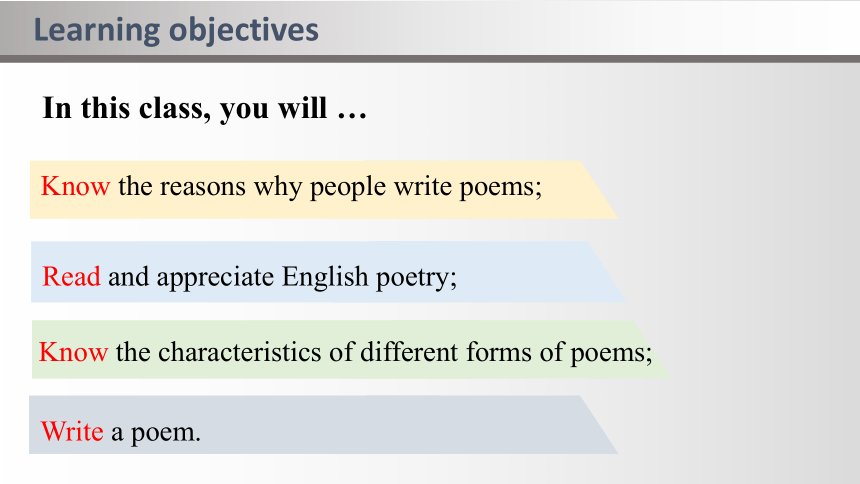
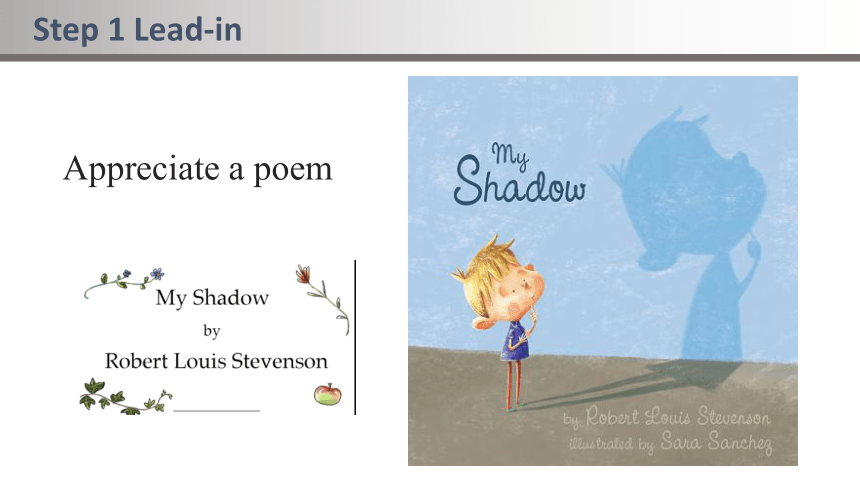
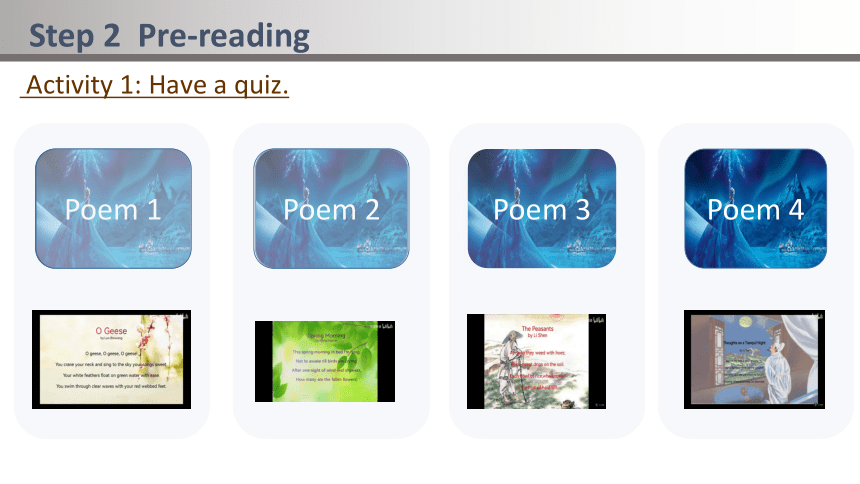
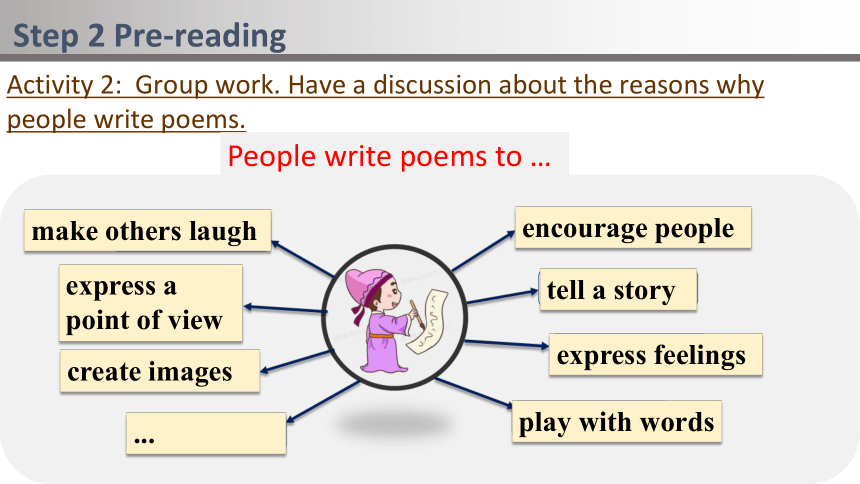
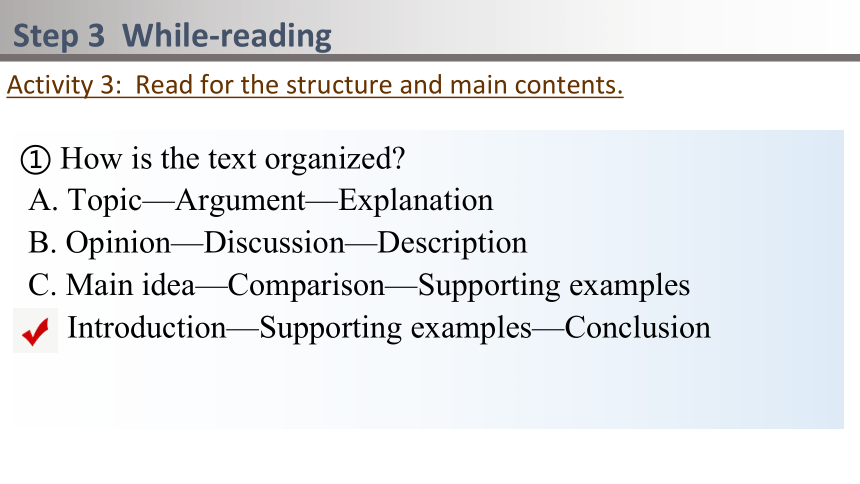
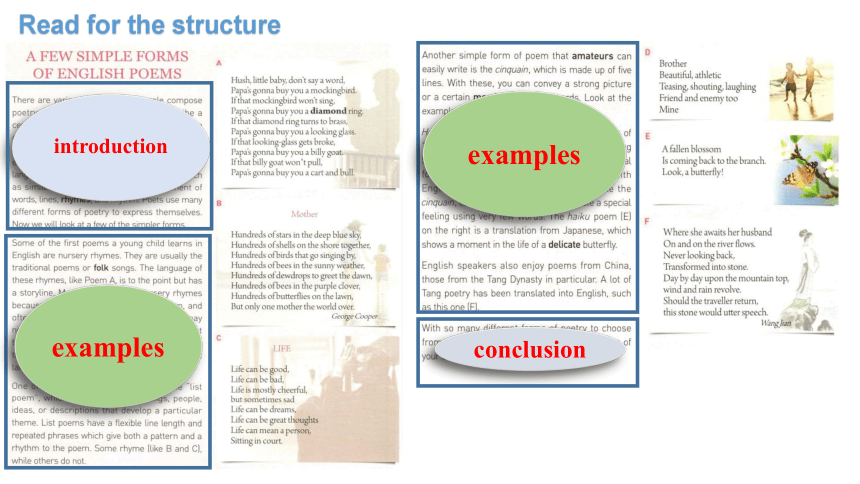
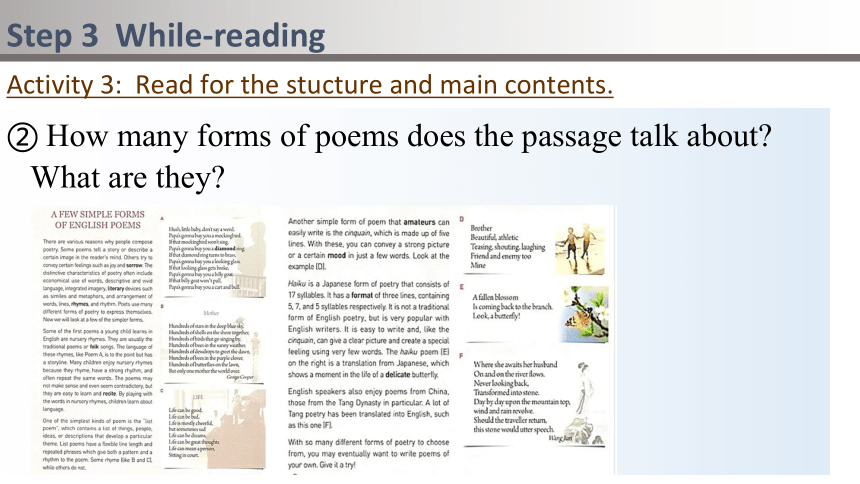
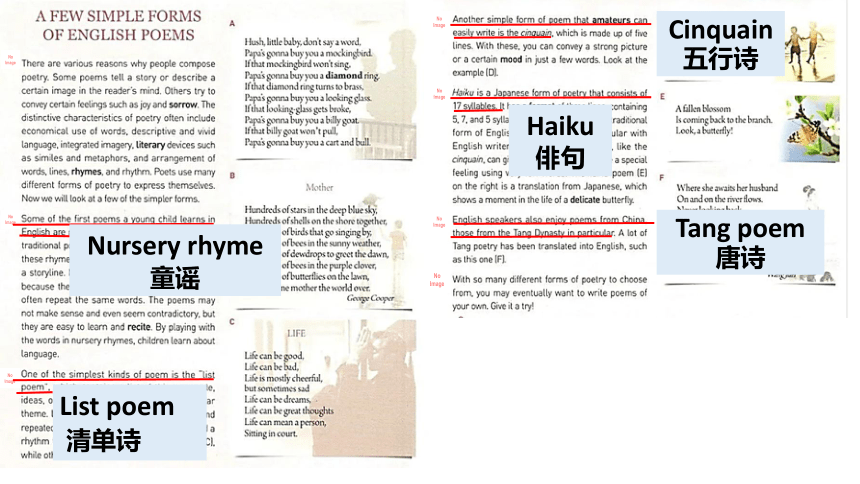
文档简介
(共25张PPT)
Reading and Thinking
Unit 5 Poems
A Few Simple Forms Of English Poems
In this class, you will …
Learning objectives
Know the reasons why people write poems;
Read and appreciate English poetry;
Know the characteristics of different forms of poems;
Write a poem.
Appreciate a poem
Step 1 Lead-in
Activity 1: Have a quiz.
Poem 1
Poem 2
Poem 3
Poem 4
Step 2 Pre-reading
Activity 2: Group work. Have a discussion about the reasons why people write poems.
Step 2 Pre-reading
People write poems to …
encourage people
tell a story
express feelings
play with words
make others laugh
express a point of view
create images
...
Activity 3: Read for the structure and main contents.
Step 3 While-reading
① How is the text organized
A. Topic—Argument—Explanation
B. Opinion—Discussion—Description
C. Main idea—Comparison—Supporting examples
D. Introduction—Supporting examples—Conclusion
Read for the structure
examples
examples
introduction
conclusion
Activity 3: Read for the stucture and main contents.
Step 3 While-reading
② How many forms of poems does the passage talk about
What are they
Nursery rhyme
童谣
List poem
清单诗
Haiku
俳句
Cinquain五行诗
Tang poem唐诗
Activity 4: Read for details.
Step 3 While-reading
Why do many children enjoy nursery rhymes
A. Because they are to the point.
B. Because they are have a storyline.
C. Because they are usually the traditional poems or folk songs.
D. Because they have not only a strong rhythm but also a repetition in words.
Form of poem Characteristics Example Topic
Nursery rhyme with a storyline; a strong ①________ ; rhyme; a lot of repetition; easy to learn and ②________ A ③______________
List poem B
C
a ④______ of things, people, ideas, or descriptions of a particular theme;
⑤__________ line length;
⑥___________ phrases for patterns and rhythm
mother’ s love
life
father’s love
list
flexible
repeated
Activity 5: Complete the chart.
rhythm
recite
Type of poem Characteristics Example Topic
Cinquain D
Haiku E
Tang poem F
simple form;
made up of ⑦_____ lines;
conveying a strong picture or a certain ⑧__________
brother
made up of ⑨_______syllables;
three lines containing 5, 7, and 5 syllables
nature
structured
⑩__________
5
mood
17
waiting
Hush, little baby, don’t say a word,
Papa’s gonna buy you a mockingbird,
If that mockingbird won’t sing,
Papa’s gonna buy you a diamond ring.
If that diamond ring turns to brass,
Papa’s gonna buy you a looking-glass.
If that looking-glass gets broke,
Papa’s gonna buy you a billy goat.
If that billy goat won’t pull,
Papa’s gonna buy you a cart and bull.
Hush, little baby, don’t say a word,
Papa’s gonna buy you a mockingbird.
If that mockingbird won’t sing,
Papa’s gonna buy you a diamond ring.
If that diamond ring turns to brass,
Papa’s gonna buy you a lookingglass.
If that looking-glass gets broke,
Papa’s gonna buy you a billygoat.
If that billygoat won’t pull,
Papa’s gonna buy you a cart and bull.
[ :d]
[ ]
[ul]
[a:s]
[ u]
Activity 6: Point out the rhyming words.
A fallen blossom
Is coming back to the branch.
Look, a butterfly!
Activity 7: Mark out the 17 syllables (音节)of Haiku E.
(5 syllables)
(7 syllables)
(5 syllables)
Activity 8: Figure out the forms of the poems.
Step 4 Post-reading
Nursery rhyme
童谣
List poem清单诗
Cinquain五行诗
Haiku俳句
Tang poem唐诗
1.
Summer
Sleepy, salty
Drying, drooping, dreading
Week in, week out
Endless
Activity 8: Figure out the forms of the poems.
Step 4 Post-reading
Nursery rhyme
童谣
List poem清单诗
Haiku俳句
Tang poem唐诗
2.
One two three four five,
Once I caught a fish alive.
Six seven eight nine ten,
Then I let it go again.
Why did you let it go
Because it bit my finger so.
Which finger did it bite
Little finger on the right.
Activity 8: Figure out the forms of the poems.
Step 4 Post-reading
List poem清单诗
Haiku俳句
Tang poem唐诗
3.
I saw a fish-pond all on fire,
I saw a house bow to a squire,
I saw a person twelve-feet high,
I saw a cottage in the sky,
I saw a balloon made of lead,
I saw a coffin drop down dead,
I saw two sparrows run a race,
I saw two horses making lace,
……
Activity 8: Figure out the forms of the poems.
Step 4 Post-reading
Haiku俳句
Tang poem唐诗
4.
Snow having melted,
The whole village is brimful
Of happy children.
(by Issa)
Activity 8: Figure out the forms of the poems.
Step 4 Post-reading
Tang poem唐诗
5.
HOME-COMING
I left home young, but come home old.
My accent unchanged, hair grizzled.
Kids, eager to know who I am,
Ask, laughingly, where the guest’s from.
There are a variety of reasons for people to write poems. In the text, five kinds of poems 1. (introduce). Some poems convey some certain emotions
2. the readers, such as well-being and sorrow; some leave a deep 3.
(impress) on the readers. What’s 4. , we learn about some characteristics of poetry through the text. Nursery rhymes seem 5. (contradict) and sometimes senseless, but they can help children learn about language. List poems have a flexible line length and 6. (repeat)phrases. Cinquain, 7.
(make) up of five lines, conveys a strong picture or a certain mood. Haiku is a Japanese form of poetry 8. (consist) of 17 syllables with only three lines. It isn’t a 9. (tradition) English form of poetry, but English writers are attracted to it. English speakers appreciate Tang poetry as well. With so many different forms of poetry 10. (choose) from, students may eventually feel like composing poems of their own.
Activity 9: Complete the summary of the text.
are introduced
to
impression
more
contradictory
repeated
made
consisting
traditional
to choose
reasons
forms
to tell a story
to express a view
to express feelings
to encourage people
to create images...
nursery rhyme
list poem
cinquain
haiku
Tang poem
Activity 10: Try to write a poem.
How to write a poem
Examples:
1
Friends
Humorous, innocent
Joking, crying, laughing
Companion and competitor
Forever
2 Dream
Hold fast to dreams,
For if dreams die
Life is a broken-winged bird
That cannot fly.
Activity 11: Pair work.
Work in pairs and read your poem to your partner.
Think about the topic and form of your partner’s poem.
Poetry is
when an emotion
has found its thought and the thought has
found words.
“A Few Simple Forms Of English Poems”
Step 5 Class summary
reasons
forms
characteristics
how to appreciate a poem
how to write a poem
After this class, I hope:
you will live your life to the fullest as if a poem;
you will be proud of Chinese poetry and culture.
1. Read and appreciate the poems in the text.
2. Go over words and expressions in Unit 5.
3. Rewrite your poem by polishing.
Homework:
Reading and Thinking
Unit 5 Poems
A Few Simple Forms Of English Poems
In this class, you will …
Learning objectives
Know the reasons why people write poems;
Read and appreciate English poetry;
Know the characteristics of different forms of poems;
Write a poem.
Appreciate a poem
Step 1 Lead-in
Activity 1: Have a quiz.
Poem 1
Poem 2
Poem 3
Poem 4
Step 2 Pre-reading
Activity 2: Group work. Have a discussion about the reasons why people write poems.
Step 2 Pre-reading
People write poems to …
encourage people
tell a story
express feelings
play with words
make others laugh
express a point of view
create images
...
Activity 3: Read for the structure and main contents.
Step 3 While-reading
① How is the text organized
A. Topic—Argument—Explanation
B. Opinion—Discussion—Description
C. Main idea—Comparison—Supporting examples
D. Introduction—Supporting examples—Conclusion
Read for the structure
examples
examples
introduction
conclusion
Activity 3: Read for the stucture and main contents.
Step 3 While-reading
② How many forms of poems does the passage talk about
What are they
Nursery rhyme
童谣
List poem
清单诗
Haiku
俳句
Cinquain五行诗
Tang poem唐诗
Activity 4: Read for details.
Step 3 While-reading
Why do many children enjoy nursery rhymes
A. Because they are to the point.
B. Because they are have a storyline.
C. Because they are usually the traditional poems or folk songs.
D. Because they have not only a strong rhythm but also a repetition in words.
Form of poem Characteristics Example Topic
Nursery rhyme with a storyline; a strong ①________ ; rhyme; a lot of repetition; easy to learn and ②________ A ③______________
List poem B
C
a ④______ of things, people, ideas, or descriptions of a particular theme;
⑤__________ line length;
⑥___________ phrases for patterns and rhythm
mother’ s love
life
father’s love
list
flexible
repeated
Activity 5: Complete the chart.
rhythm
recite
Type of poem Characteristics Example Topic
Cinquain D
Haiku E
Tang poem F
simple form;
made up of ⑦_____ lines;
conveying a strong picture or a certain ⑧__________
brother
made up of ⑨_______syllables;
three lines containing 5, 7, and 5 syllables
nature
structured
⑩__________
5
mood
17
waiting
Hush, little baby, don’t say a word,
Papa’s gonna buy you a mockingbird,
If that mockingbird won’t sing,
Papa’s gonna buy you a diamond ring.
If that diamond ring turns to brass,
Papa’s gonna buy you a looking-glass.
If that looking-glass gets broke,
Papa’s gonna buy you a billy goat.
If that billy goat won’t pull,
Papa’s gonna buy you a cart and bull.
Hush, little baby, don’t say a word,
Papa’s gonna buy you a mockingbird.
If that mockingbird won’t sing,
Papa’s gonna buy you a diamond ring.
If that diamond ring turns to brass,
Papa’s gonna buy you a lookingglass.
If that looking-glass gets broke,
Papa’s gonna buy you a billygoat.
If that billygoat won’t pull,
Papa’s gonna buy you a cart and bull.
[ :d]
[ ]
[ul]
[a:s]
[ u]
Activity 6: Point out the rhyming words.
A fallen blossom
Is coming back to the branch.
Look, a butterfly!
Activity 7: Mark out the 17 syllables (音节)of Haiku E.
(5 syllables)
(7 syllables)
(5 syllables)
Activity 8: Figure out the forms of the poems.
Step 4 Post-reading
Nursery rhyme
童谣
List poem清单诗
Cinquain五行诗
Haiku俳句
Tang poem唐诗
1.
Summer
Sleepy, salty
Drying, drooping, dreading
Week in, week out
Endless
Activity 8: Figure out the forms of the poems.
Step 4 Post-reading
Nursery rhyme
童谣
List poem清单诗
Haiku俳句
Tang poem唐诗
2.
One two three four five,
Once I caught a fish alive.
Six seven eight nine ten,
Then I let it go again.
Why did you let it go
Because it bit my finger so.
Which finger did it bite
Little finger on the right.
Activity 8: Figure out the forms of the poems.
Step 4 Post-reading
List poem清单诗
Haiku俳句
Tang poem唐诗
3.
I saw a fish-pond all on fire,
I saw a house bow to a squire,
I saw a person twelve-feet high,
I saw a cottage in the sky,
I saw a balloon made of lead,
I saw a coffin drop down dead,
I saw two sparrows run a race,
I saw two horses making lace,
……
Activity 8: Figure out the forms of the poems.
Step 4 Post-reading
Haiku俳句
Tang poem唐诗
4.
Snow having melted,
The whole village is brimful
Of happy children.
(by Issa)
Activity 8: Figure out the forms of the poems.
Step 4 Post-reading
Tang poem唐诗
5.
HOME-COMING
I left home young, but come home old.
My accent unchanged, hair grizzled.
Kids, eager to know who I am,
Ask, laughingly, where the guest’s from.
There are a variety of reasons for people to write poems. In the text, five kinds of poems 1. (introduce). Some poems convey some certain emotions
2. the readers, such as well-being and sorrow; some leave a deep 3.
(impress) on the readers. What’s 4. , we learn about some characteristics of poetry through the text. Nursery rhymes seem 5. (contradict) and sometimes senseless, but they can help children learn about language. List poems have a flexible line length and 6. (repeat)phrases. Cinquain, 7.
(make) up of five lines, conveys a strong picture or a certain mood. Haiku is a Japanese form of poetry 8. (consist) of 17 syllables with only three lines. It isn’t a 9. (tradition) English form of poetry, but English writers are attracted to it. English speakers appreciate Tang poetry as well. With so many different forms of poetry 10. (choose) from, students may eventually feel like composing poems of their own.
Activity 9: Complete the summary of the text.
are introduced
to
impression
more
contradictory
repeated
made
consisting
traditional
to choose
reasons
forms
to tell a story
to express a view
to express feelings
to encourage people
to create images...
nursery rhyme
list poem
cinquain
haiku
Tang poem
Activity 10: Try to write a poem.
How to write a poem
Examples:
1
Friends
Humorous, innocent
Joking, crying, laughing
Companion and competitor
Forever
2 Dream
Hold fast to dreams,
For if dreams die
Life is a broken-winged bird
That cannot fly.
Activity 11: Pair work.
Work in pairs and read your poem to your partner.
Think about the topic and form of your partner’s poem.
Poetry is
when an emotion
has found its thought and the thought has
found words.
“A Few Simple Forms Of English Poems”
Step 5 Class summary
reasons
forms
characteristics
how to appreciate a poem
how to write a poem
After this class, I hope:
you will live your life to the fullest as if a poem;
you will be proud of Chinese poetry and culture.
1. Read and appreciate the poems in the text.
2. Go over words and expressions in Unit 5.
3. Rewrite your poem by polishing.
Homework:
